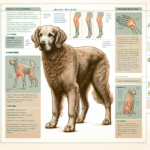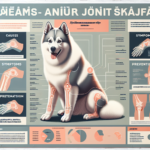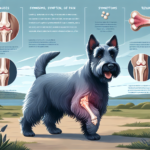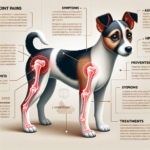Afghan Hound Joint Pain: Causes, Symptoms, Prevention, and Treatment
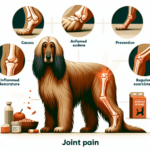
Introduction
The Afghan Hound is a breed known for its elegance, grace, and distinctive appearance. Originating from the mountainous regions of Afghanistan, this breed has a rich history dating back thousands of years. Afghan Hounds are characterized by their long, flowing coats, narrow heads, and a proud, aloof demeanor. They were originally bred for hunting large game in harsh terrains, which speaks to their agility and endurance.
Despite their regal appearance and athletic prowess, Afghan Hounds are not immune to health issues. Like many other breeds, they can suffer from a range of health concerns, including joint pain. Joint health is particularly crucial for Afghan Hounds due to their active nature and the physical demands placed on their bodies.
Breed-Specific Joint Pain Risks
Genetic Predisposition
Afghan Hounds, like many purebred dogs, have a genetic predisposition to certain joint-related issues. Hip dysplasia, a condition where the hip joint doesn’t fit properly into the hip socket, is relatively common in this breed. This can lead to arthritis and significant pain over time. Elbow dysplasia, another genetic condition, affects the elbow joints and can cause similar issues.
Age-Related Risks
As Afghan Hounds age, the risk of developing joint pain increases. The breed typically reaches senior status around 7-8 years of age. During this time, the wear and tear on their joints from years of activity can lead to conditions like osteoarthritis. It’s essential for owners to be vigilant about their dog’s joint health as they approach these age milestones.
Activity Level and Joint Stress
Afghan Hounds are known for their high energy levels and need for regular exercise. While this is beneficial for their overall health, it can also contribute to joint stress. Activities like running, jumping, and playing can put significant strain on their joints, especially if not managed properly. Owners should be mindful of the types and intensity of activities their Afghan Hound engages in to minimize joint stress.
Common Symptoms of Joint Pain in Afghan Hounds
General Symptoms
- Limping or favoring one leg
- Stiffness, especially after rest
- Reluctance to move or climb stairs
- Decreased activity or playfulness
- Swelling around the joints
- Whining or showing signs of discomfort when touched
Breed-Specific Symptoms
In Afghan Hounds, joint pain may manifest in subtle ways due to their stoic nature. Owners might notice a decrease in their dog’s willingness to engage in activities they once enjoyed, such as running or playing fetch. Additionally, the breed’s long coat can sometimes hide physical signs of swelling or discomfort, making it crucial for owners to pay close attention to behavioral changes.
When to Consult a Vet
If an Afghan Hound shows any signs of joint pain, it’s essential to consult a veterinarian promptly. Early intervention can prevent the condition from worsening and improve the dog’s quality of life. Specific red flags include persistent limping, noticeable pain when moving, or any sudden changes in behavior or activity levels.
Preventive Measures for Joint Health
Exercise Recommendations
Regular, moderate exercise is key to maintaining joint health in Afghan Hounds. Activities like walking, swimming, and controlled play are excellent options. These exercises help keep the joints flexible and muscles strong without putting excessive strain on them. It’s important to avoid high-impact activities like jumping or running on hard surfaces, which can exacerbate joint issues.
Dietary Suggestions
A balanced diet rich in essential nutrients can support joint health. Foods containing glucosamine and chondroitin are particularly beneficial for joint cartilage. Omega-3 fatty acids, found in fish oil, can help reduce inflammation. Owners should consult their veterinarian for specific dietary recommendations and consider supplements if necessary.
Weight Management
Maintaining a healthy weight is crucial for reducing joint stress. Excess weight puts additional pressure on the joints, exacerbating pain and discomfort. Afghan Hound owners should monitor their dog’s weight closely and adjust their diet and exercise routine as needed to keep them at an optimal weight.
Early Screening and Monitoring
Regular veterinary check-ups are essential for early detection of joint issues. Screening tests like X-rays can help identify conditions like hip dysplasia before they become severe. Early intervention can significantly improve the prognosis and quality of life for Afghan Hounds with joint problems.
Treatment Options for Joint Pain
Non-Surgical Treatments
For mild to moderate joint pain, non-surgical treatments can be highly effective. These may include:
- Medications: Anti-inflammatory drugs and pain relievers can help manage symptoms.
- Physical Therapy: Exercises and treatments designed to improve joint function and reduce pain.
- Lifestyle Adjustments: Modifying the dog’s activity level and environment to reduce joint stress.
Surgical Options
In severe cases, surgical intervention may be necessary. Common surgical options for joint pain in Afghan Hounds include:
- Hip Replacement: Replacing the damaged hip joint with an artificial one.
- Arthroscopy: A minimally invasive procedure to clean out the joint.
- Joint Fusion: Fusing the joint to reduce pain and improve stability.
Alternative Therapies
Alternative treatments can also be beneficial for managing joint pain. These may include:
- Acupuncture: Using needles to stimulate specific points on the body to relieve pain.
- Hydrotherapy: Water-based exercises that reduce joint stress while improving strength and flexibility.
- Massage: Therapeutic massage to improve circulation and reduce muscle tension around the joints.
Lifestyle and Management Tips
Daily Care Routine
A consistent daily care routine can help manage joint pain in Afghan Hounds. This might include:
- Regular, gentle exercise like walking or swimming.
- A balanced diet with joint-supporting nutrients.
- Administering any prescribed medications or supplements.
- Monitoring the dog’s weight and adjusting their diet as needed.
Modifying the Home Environment
Making the home more comfortable for a dog with joint pain can significantly improve their quality of life. Consider the following modifications:
- Installing ramps to help the dog navigate stairs.
- Providing orthopedic beds for better joint support.
- Ensuring food and water bowls are at a comfortable height.
Long-Term Management
Long-term management of joint pain involves ongoing care and monitoring. Regular veterinary check-ups, maintaining a healthy lifestyle, and being attentive to any changes in the dog’s condition are crucial. With proper management, Afghan Hounds can continue to lead active and happy lives despite joint pain.
FAQs About Afghan Hounds and Joint Pain
What are the early signs of joint pain in Afghan Hounds?
Early signs include limping, stiffness, reluctance to move, and decreased activity levels. Owners should also watch for subtle changes in behavior, such as a lack of enthusiasm for activities they once enjoyed.
Can joint pain in Afghan Hounds be prevented?
While genetic predispositions can’t be entirely prevented, maintaining a healthy weight, providing a balanced diet, and ensuring regular, moderate exercise can significantly reduce the risk of joint pain.
Are there specific foods that can help with joint health?
Yes, foods rich in glucosamine, chondroitin, and omega-3 fatty acids can support joint health. Owners should consult their veterinarian for specific dietary recommendations and consider supplements if necessary.
When should I take my Afghan Hound to the vet for joint pain?
If your dog shows persistent signs of joint pain, such as limping, stiffness, or reluctance to move, it’s essential to consult a veterinarian promptly. Early intervention can prevent the condition from worsening.
What are the best exercises for an Afghan Hound with joint pain?
Low-impact exercises like walking and swimming are ideal for Afghan Hounds with joint pain. These activities help maintain joint flexibility and muscle strength without putting excessive strain on the joints.
Conclusion
Joint pain is a common issue for Afghan Hounds, but with proper care and management, it can be effectively addressed. By understanding the breed-specific risks, recognizing early symptoms, and taking preventive measures, owners can help ensure their Afghan Hound remains active and healthy. Regular veterinary check-ups and a tailored care routine are essential for maintaining joint health and improving the quality of life for these elegant and graceful dogs.
Remember, early intervention and consistent care are key to managing joint pain in Afghan Hounds. By staying informed and proactive, you can help your dog lead a happy, pain-free life.

